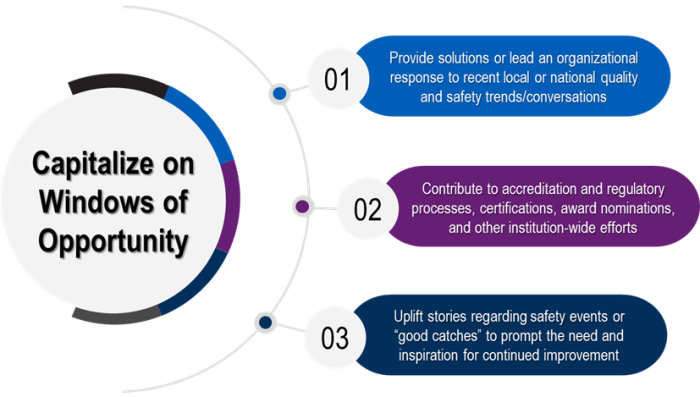Windows of opportunity occur when the impetus for change has grown to a tipping point where new actions, such as investment into a CE’s work, are possible. The impetus for change refers to a health system’s willingness and motivation to invest more resources into a particular mission. For CEs, the impetus refers to their health system’s eagerness to invest in quality and safety improvement programming, staff, and research to improve the care their patients receive.
Many factors may contribute to an impetus for change, but all are focused on improving patient and organizational outcomes. Examples include:
- A patient safety event that led to media coverage.
- Publicly reported quality, safety, and patient experience data or scores.
- A large malpractice payout.
- A paradigm-shifting publication in diagnostic safety.
- A quality award that the health system is striving to win.
- A policy or regulatory change with which the health system must comply.
The factors that drive the impetus for change present as windows of opportunity for CEs to collaborate within and across their health system. These windows of opportunity must be recognized and acted on. Leaders of CEs can use challenging situations to accomplish long-range goals and see the potential in the most difficult situations.
Responses to Opportunities
CEs can strategically position themselves as leaders to respond to these events, paradigm shifts, discoveries, and policy and regulatory changes surrounding quality and safety within their healthcare system. For example, the 2015 National Academies of Sciences, Engineering, and Medicine (NASEM) report Improving Diagnosis in Healthcare created a paradigm shift in healthcare. This shift presented a window of opportunity for healthcare institutions to fulfill the NASEM report’s recommendations to create reporting systems for diagnostic error, promote teamwork across interdisciplinary teams, and enhance patient engagement in the diagnostic process.26 Major U.S. health systems were responsive to this report, which created a cascade of research and programming to improve diagnostic safety nationwide.27
To prioritize their work and related impacts, CEs can embed their efforts in emerging accreditation, regulatory, and performance measurement priorities. For example, the Leapfrog Group will integrate recommended practices for improving diagnosis into the upcoming 2025 Leapfrog Hospital Survey as part of its Recognizing Excellence in Diagnosis Initiative.28,29 CEs aware of these recommendations can align and prioritize their improvements with the forthcoming recommendations.
The ability to be proactive is coupled with being aligned and integrated with the healthcare system. It is critical that CEs establish communication channels with their administrative executives, division directors, and patient safety teams to be part of the solution to emerging issues.
The impetus for change often comes from powerful patient stories that evoke strong responses and action. For example, stories of a medical error that led a young boy to die of sepsis prompted multiple statewide initiatives to improve timely sepsis management.25,26 In addition, Lukas, et al., describe how one institution in their qualitative study on systems change for quality improvement was profoundly impacted when a physician within their own organization experienced a medication error. This incident galvanized the institution’s executive leadership to take decisive action.16

Exhibit 5. Three actions to convert on windows of opportunity
Guiding Questions for Windows of Opportunity
- How can the CE turn its knowledge of quality and safety risks and solutions into patient, caregiver, and provider stories to motivate improvement efforts?
- What new regulatory and accreditation requirements can the CE help support institutional compliance with?
- Can the CE provide immediate solutions or lead an organizational response to recent local or national quality and safety trends or conversations?
- Can the CE engage patients and the community in quality and safety improvement?
Capitalizing on a Window of Opportunity: Parkland Center for Clinical Innovation
Parkland Center for Clinical Innovation (PCCI) is a nonprofit healthcare analytics research and development organization seeking to drive patient-centered care research and practice. Our interview with leadership in the Gordon and Betty Moore Foundation, President Harvey Fineberg and Chief Administrative Officer Marybeth Sharpe, highlighted how PCCI capitalized on a window of opportunity.
In 2010, the Centers for Medicare & Medicaid Services (CMS) began the Hospital Readmissions Reduction Program (HRRP) under Section 1886(q) of the Social Security Act. This regulatory change reduced payments made to hospitals for excess and avoidable readmissions. CMS penalized hospitals if they had outsized readmissions compared with hospitals with similar proportions of Medicare-Medicaid dual-eligible populations.
PCCI saw this mandate as a window of opportunity. In response, they developed programming to assist institutions in complying with this regulation and reducing avoidable readmissions by improving care coordination and engagement for both patients and clinicians. This swift reaction to a new regulatory requirement enabled PCCI to establish a long-term, financially sustainable strategy after aligning its mission to that of healthcare systems seeking to comply with CMS’s HRRP program.



